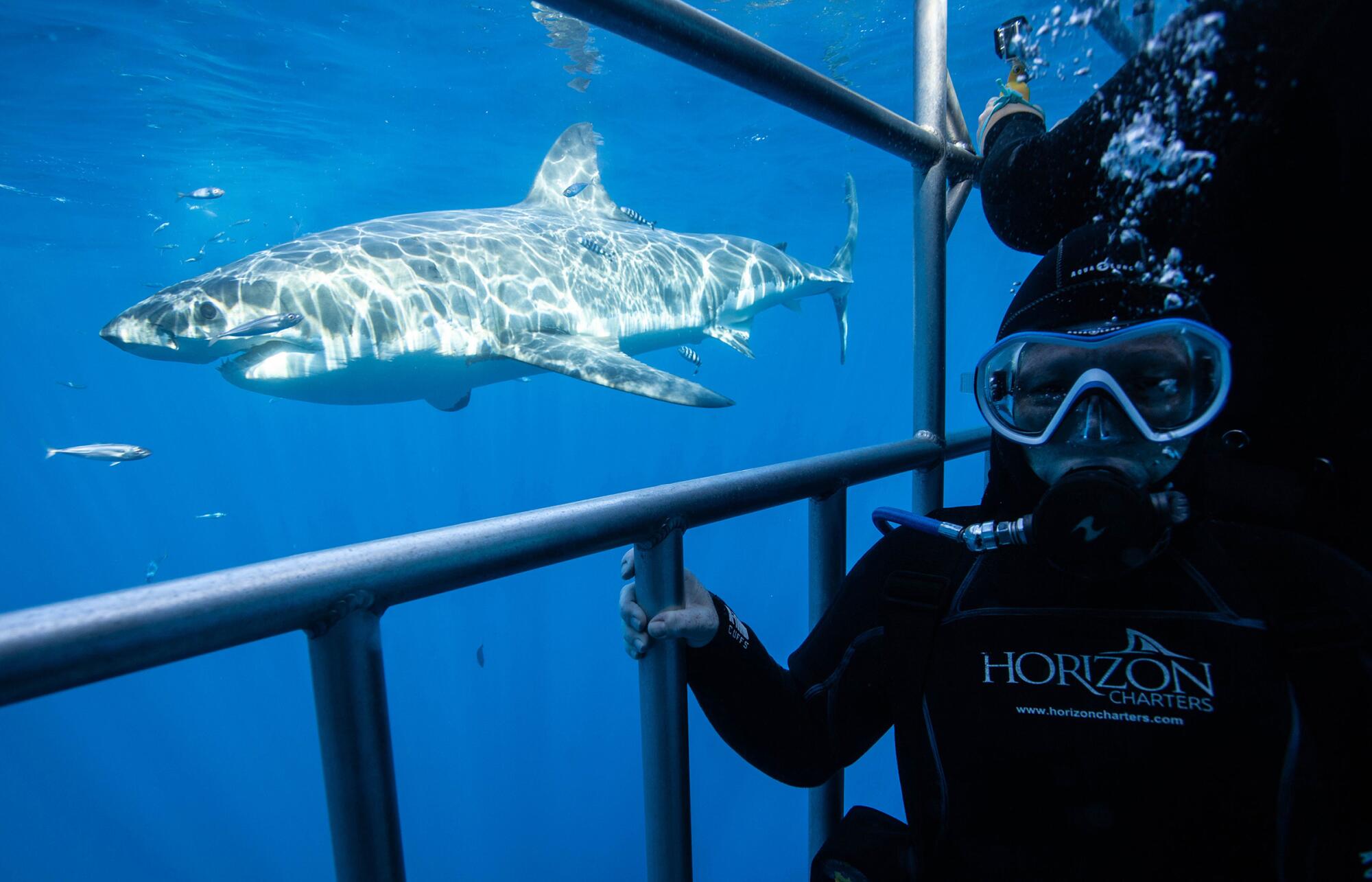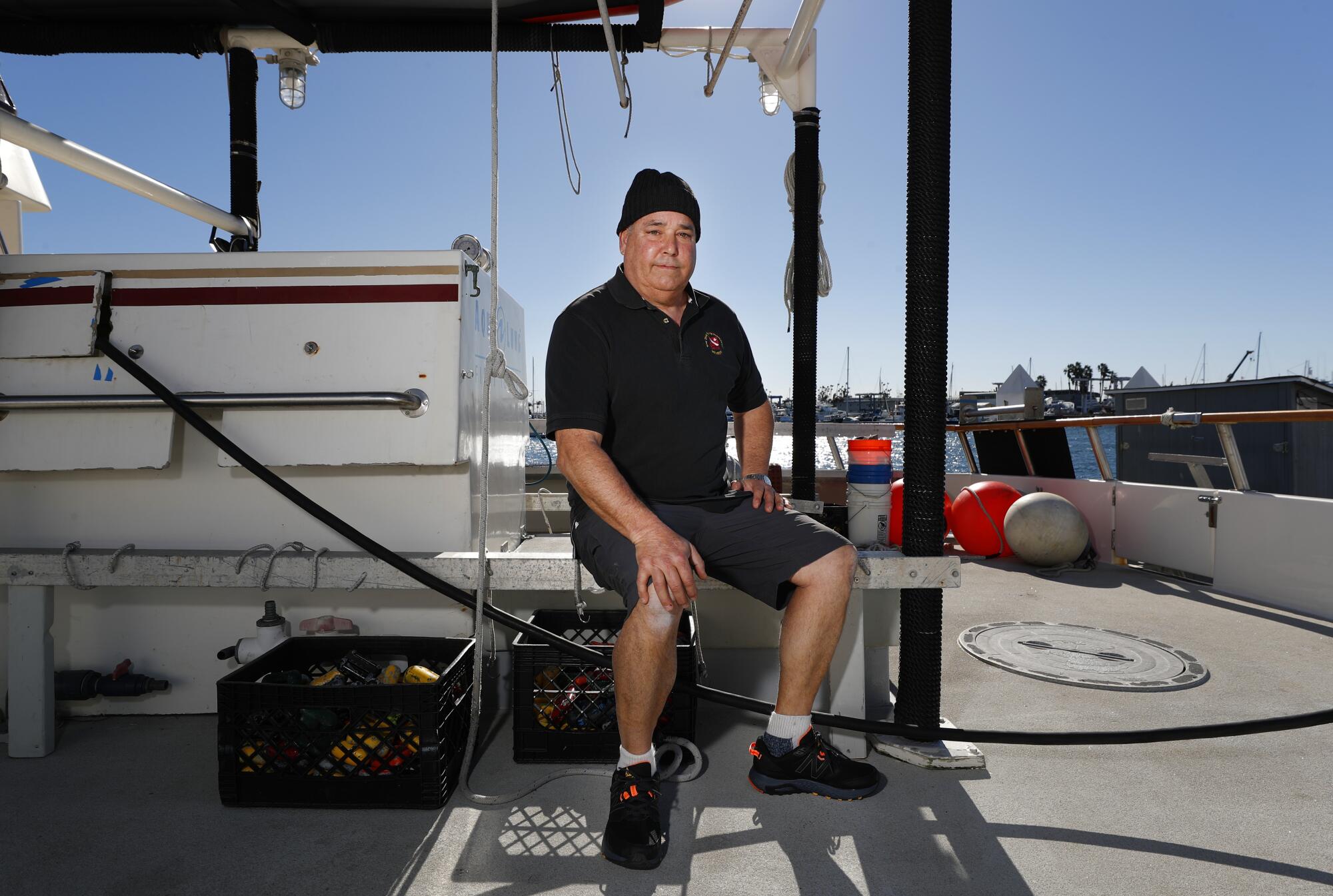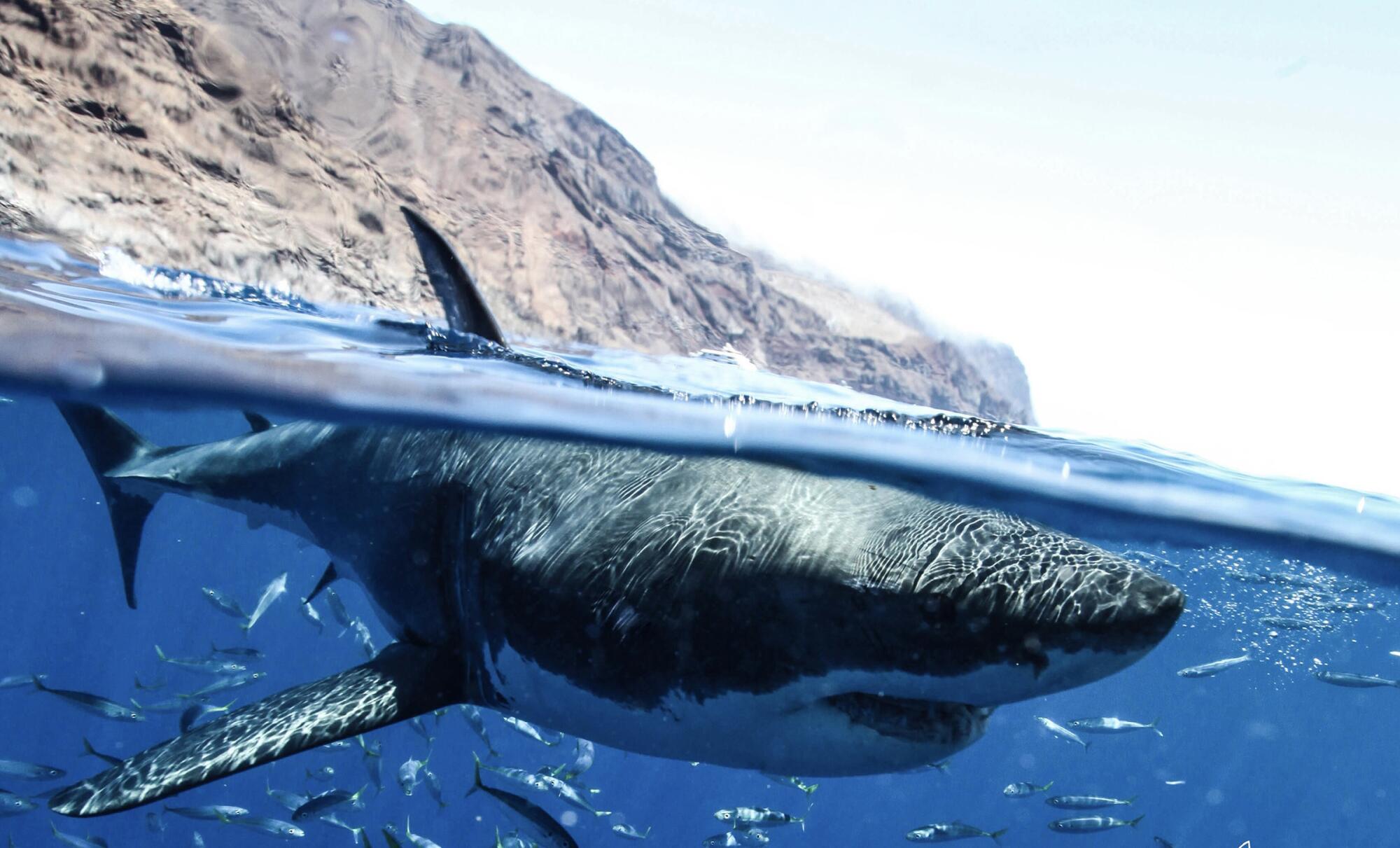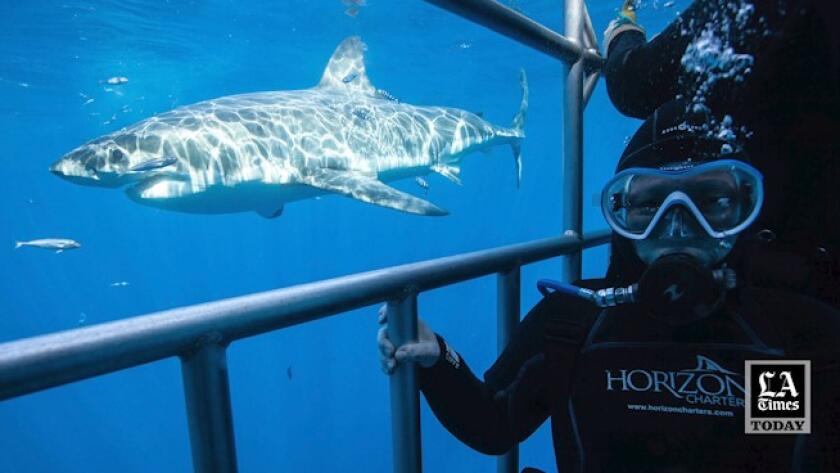
- Share via
Hordes of tourists, scientists and professional film crews have for years flocked to Guadalupe Island off Baja California, eager to get within arm’s reach of a great white shark.
The party now appears to be over for the cage-diving industry. The Mexican government in January indefinitely banned such activities around the island, citing numerous “bad practices.”
This story is for subscribers
We offer subscribers exclusive access to our best journalism.
Thank you for your support.
Charter boat owners and researchers are bemoaning the loss. Many fear the rules could backfire, allowing poachers to cash in on shark fins and jaws.
Although the country could still reverse course, the moment feels like the end of an era — one marked by revelry, scientific discoveries, injured animals and television stunts gone awry.
Spencer Salmon has had enough, ambivalent about an industry he helped pioneer. The longtime San Diegan recently sold one of the most iconic boats in the business, an 82-foot sportfisher known as the Horizon.
“As much as it pains me, we knew this day was coming,” the 40-year-old recently told the Union-Tribune. “It wasn’t a secret.”
Two shark cages, recently upgraded for about $20,000, now sit idle at his home, grass growing up through the bars.
Like ‘seeing a dinosaur’
Guadalupe Island started as a fishing and dive spot but moved to cages around the turn of the century. It quickly became one of the most coveted spots on the planet to view great white sharks thanks to the often placid, 70-degree water lasting well into December. Its popularity was rivaled only by Australia and South Africa.
“South Africa was great,” said Lalo Saidy, 43, a dive instructor who recently worked on the Horizon. “There’s a lot more surface action. Sharks use that to their advantage with hunting. There’s breaching.
“Whereas, Guadalupe, with the clean visibility, is all underwater stuff,” he added. “You see a whole new side to the animal that you were missing out on.”
Salmon spent his early adult life as a deckhand and eventually became the second captain on the Horizon, routinely making the daylong voyage from Point Loma to the volcanic island about 150 miles off the coast of central Baja California.
He remembers entertaining packed expeditions with nine crew members and up to 16 passengers — familiar families, bright-eyed amateur photographers, researchers eager to tag and study the 15- to 20-foot giants.
“The boat was set up really well,” said Salmon, on a recent tour of the Horizon, docked at H&M Landing in San Diego Bay, “three showers, two bathrooms, clothes driers, racks to store your personal gear.
“We have a full galley back there,” he said from a commodious dining room, “typically with two chefs, cooking up three meals a day, plus snacks, desserts, all that good stuff.”
A big draw was how easy it was. All folks had to do was pony up $2,000 to $5,000 for a five-day trip between August and December and endure a full day of transit, first getting passports stamped in Ensenada, Mexico, and then 18 more hours motoring deep into the Pacific Ocean.
Cary Humphries, 60, who captained the Horizon for many years and eventually worked for Salmon, described the experience as “exhilarating.”

“I’ve seen big sharks while spearfishing, but you don’t realize how big they are until they’re right in your face,” he said. “I would compare it to seeing a dinosaur.”
At the final destination, Horizon would anchor off the northeast cove of the island. Food and booze were plentiful. After a hardy breakfast, people would jump into the metal cages attached to the back of the boat. Then the crew would “chum” the water with tuna heads, and the performance would snap into action.
“You could throw somebody who wasn’t even a scuba diver in those cages,” said Chris Lowe, director of the Shark Lab at Cal State Long Beach. “They would get this opportunity of a lifetime to go to Jurassic Park basically.”
But just like the blockbuster movie, things didn’t always go as planned.
Blood in the water

Perhaps the most disturbing situations at Guadalupe Island involved injured sharks.
In 2016, while chasing bait, one smashed into a cage attached to the Somar V, a boat owned by the Mexico-based Pacific Fleet. The animal thrashed violently through the bars and was momentarily trapped inside with a diver.
Video of the incident shows a quick-thinking crew member throwing the top of the cage open, allowing the shark to flop out, blood streaming from its gills. Moments later the diver emerges from the water, seemingly unharmed.
Rather than damaging Pacific Fleet’s reputation, the video attracted more customers, and the company quickly bought a second boat.
Spokesperson Ronald Cepeta acknowledged the incident, saying the business worked hard to comply with the government’s frequently changing regulations.
“I’m not proud of what happened in 2016, but it’s part of interacting with wild animals,” he said. “We know how erratic the juveniles can be, how explosive.”
A similar incident in 2019 ended in the likely death of a white shark that got trapped between the bars of a cage. Divers can be seen in a video cowering as the animal struggles to get free, blood pouring from around its head. Eventually, the shark sinks motionless into the depths of the ocean.
The charter boat operator involved in the incident, Canadian-based Nautilus Dive Adventures, did not return a request for comment.
The Mexican government singled out these incidents in its Jan. 9 management document that, until further notice, bans cage diving at the island. It also referenced “bad practices,” including divers outside of cages, the improper use of bait and the dumping of pollutants.
Mexico’s Natural Protected Areas Commission, the environmental agency that helped make the decision, did not respond to questions about the situation in time for publication.
Some have speculated a Mexican fishing collective in Baja California, employing several dozen abalone and lobster divers on the island, pushed for restrictions.

Salmon of the Horizon put it this way: “More boats, more problems.”
At its peak, he said, there were as many as nine vessels anchored off the island at any given time, with music blasting, reckless behavior and little enforcement of the rules.
Asked if boats were dumping pollution, such as sludge- and oil-filled bilge tanks, he said, “You name it. They did it.”
A major point of contention was the cage design. Film crews wanted larger spaces through which to record the sharks in action. But that also created more opportunities for the animals to get caught between the bars.
Discovery Channel’s drive to provide ever-more novel entertainment for its long-running “Shark Week” series narrowly avoided tragedy in 2021 when a 16-foot shark tore through a clear polycarbonate plastic observation tub. A diver had to swim for his life as the container splintered into pieces.
By comparison, many point to the Horizon as a model of responsible shark diving. After Salmon bought the boat in 2015, he worked closely with the Mexican government to fine-tune cage regulations, including using rounded edges and limiting the space between bars.
Although he admits that’s not the whole story.
“We’ve had sharks smash through our cages, rip bars off,” he said. “We’re definitely better, but we’re not perfect. We were not the good guys by any stretch of the imagination.”
A productive laboratory

Despite the controversy, cage diving was also a celebration of a once-imperiled species. Conservation laws enacted over recent decades, including a 1994 ban on catching white sharks in California, were working. And here was the proof.
“They had been over-fished for decades, and their primary food source, marine mammals, had been hunted to the verge of extinction by the early 1900s,” said Lowe of Cal State Long Beach, one of the state’s top shark researchers. “Their populations had probably been suppressed for well over a 100 years.”
Many feared they would go extinct. Gov. Jerry Brown went so far as to ban the sale and even possession of shark fins in 2011.
It’s now estimated there could be as many as 4,000 white sharks in the eastern Pacific swimming between Mexico and Alaska, Lowe said, with the caveat that many people put the number far lower.
Lowe and other researchers joined the excursions eager to learn more about these mysterious creatures. The island provided an ideal laboratory, especially compared with the murky waters around San Francisco’s long-running research site at the Farallon Islands.
Scientists credited charter boat trips, such as on the Horizon, as crucial to understanding migratory and feeding patterns for sharks along the eastern Pacific.
“The best we know based on genetics, this is a separate population discrete from the northwest population off Japan and Russia,” explained Lowe. “There’s another population off New Zealand and Australia.”
Charlie Huveneers, a marine ecologist at Flinders University in South Australia, said on his side of the globe, charter boat operators have taken researchers cage diving since as far back as the 1970s.
“With white sharks, operators have provided a logistical platform that has enabled a lot of really important research,” he said, adding that otherwise, the science would be “much harder due to limited resources and funding.”

Some now fear the ban will do more harm than good. Specifically, shark diving professionals have argued that in their absence, poachers will flock to the island in search of a fast buck.
“A single set of white shark jaws goes for about $5,000. White shark fins can go for up to $10,000,” said longtime tour guide Patric Douglas, who helped book trips for the Horizon. “It was the fact that we were there for most of the season that protected these animals.”
Illegal fishing of the 120-pound totoaba in the nearby Gulf of California is well documented and has brought the vaquita porpoise to the edge of extinction. The harvest of white sharks in that area has been reported as recently as 2017.
For the record:
3:49 p.m. Feb. 6, 2023An earlier version of this report mentioned illegal fishing of the totoaba in the Gulf of Mexico. The correct area is the Gulf of California.
Researchers say poaching at Guadalupe Island could have a devastating effect on the population of white sharks in the eastern Pacific.
“We’ve already started to do back-of-the-envelope calculations about how many mature females you would have to kill before we saw populations start to decline,” said Lowe, “and it really could be as few as 30 in a year.”
Union-Tribune staff writer Alexandra Mendoza contributed to this report.
- Share via
Watch L.A. Times Today at 7 p.m. on Spectrum News 1 on Channel 1 or live stream on the Spectrum News App. Palos Verdes Peninsula and Orange County viewers can watch on Cox Systems on channel 99.
More to Read
Sign up for Essential California
The most important California stories and recommendations in your inbox every morning.
You may occasionally receive promotional content from the Los Angeles Times.















